Killer Monkeys
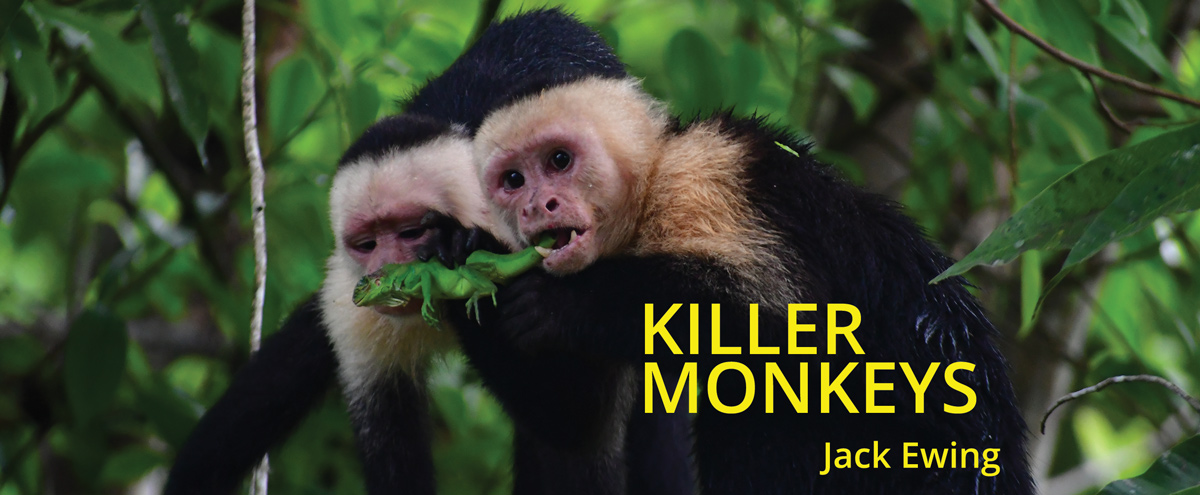
Monkeys in the zoo are fun to watch, but observing them in the wild is almost like watching an entirely different species in a similar body. My first wild monkey sighting was a very emotional experience, and each subsequent encounter with white-throated capuchin monkeys (Cebus capucinus) nudged my curiosity a bit farther. Even today, 47 years after that first glimpse of a black and white primate scampering up a tree, they still fascinate me. Capuchins are always coming up with surprises and exhibiting never before seen behavior. Later I was to learn that they are the most intelligent of Costa Rica’s four monkey species.
In the 1970s and 80s written information about wildlife was almost non-existent. There were no bird or mammal books to be found, no internet, and not even any laminated information sheets with photos. For the next 18 years, until the first field guide, Neotropical Rainforest Mammals, was published, personal observation, as well as listening to campesino friends, neighbors, and workers provided the knowledge I so sought after.
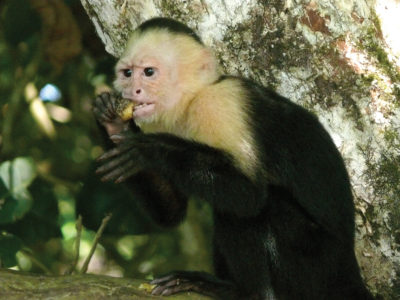 I observed the capuchins playing, fighting, and foraging for fruits, flowers and buds. I watched them in the trees, on the ground, and in the shallow water. Everybody told me that they could be vicious, but I really didn’t believe them. Threat displays were commonplace, but nothing I would call vicious. The only somewhat aggressive behavior I had observed was a troop of monkeys harassing a three-toed sloth. It was obvious they were being very careful to avoid the sloth’s powerful, grasping claws, but I took this incident to be more of an amusement for the monkeys than a harmful act. I figured that maybe a female could be vicious if another animal threatened her young, but nothing more. I decided that the word “vicious” was probably an exaggeration. Then one day the workers returned from fixing a fence near the mangrove and excitedly told me of a thrilling experience they had just had. Three capuchin monkeys captured a mature, egg bearing, female green iguana, ripped her open and devoured the eggs in her belly. Then they started on her flesh, occasionally sharing scraps with the rest of the troop. At some point during this ordeal the iguana died. Once the monkeys had her in their grasp they weren’t concerned with taking time to kill her. She wasn’t going anywhere, and eating was their top priority.
I observed the capuchins playing, fighting, and foraging for fruits, flowers and buds. I watched them in the trees, on the ground, and in the shallow water. Everybody told me that they could be vicious, but I really didn’t believe them. Threat displays were commonplace, but nothing I would call vicious. The only somewhat aggressive behavior I had observed was a troop of monkeys harassing a three-toed sloth. It was obvious they were being very careful to avoid the sloth’s powerful, grasping claws, but I took this incident to be more of an amusement for the monkeys than a harmful act. I figured that maybe a female could be vicious if another animal threatened her young, but nothing more. I decided that the word “vicious” was probably an exaggeration. Then one day the workers returned from fixing a fence near the mangrove and excitedly told me of a thrilling experience they had just had. Three capuchin monkeys captured a mature, egg bearing, female green iguana, ripped her open and devoured the eggs in her belly. Then they started on her flesh, occasionally sharing scraps with the rest of the troop. At some point during this ordeal the iguana died. Once the monkeys had her in their grasp they weren’t concerned with taking time to kill her. She wasn’t going anywhere, and eating was their top priority.
Upon hearing about this experience I realized that the campesinos hadn’t been exaggerating at all. Monkeys really could be vicious. Though I had always been fascinated with these wild primates, I had never really observed the details of their behavior. From that day forward, every time I came across a troop I paid close attention to their actions. It soon became obvious that vegetable matter was only part of their diets. A couple of days after the iguana incident I observed a monkey catch a grasshopper and pop it into his mouth. Several months later I saw two of them destroy a bird’s nest and eat something from inside, though I was unable to see if it was eggs or hatchlings. At some point I saw a young capuchin chase something up a branch, finally snatching it off the limb with his hand. When he paused briefly to admire the prey before stuffing it into his mouth, I could see that it was a small lizard. One of the workers told me he had seen two monkeys on the ground digging maggots out of a rotten cacao pod and eating them. It was becoming obvious that white-faced capuchin monkeys were far from the peace loving vegans I had imagined them to be. They would eat any source of animal protein that presented itself, and if that required being vicious killers, so be it. Thinking back on it now, I realize that their prominent canine teeth, often visible during threat displays, should have given me a clue.
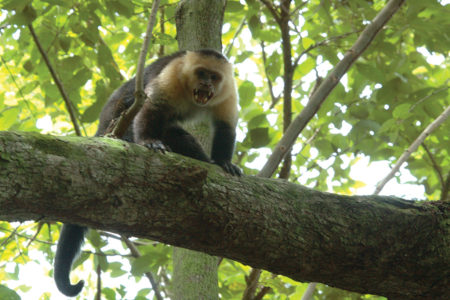 With the onset of the environmental movement and ecological tourism in Costa Rica, I often came in contact with field biologists who shared stories about their work. One of the most interesting came from a couple, both biologists, from Guanacaste. Mammals of the tropical dry forest was their field of study, and white-nosed coatis their specialty. Coatis build nests in trees by lining crevices with leaves or by constructing nests of leaves in thick clumps of branches. The young are helpless for the first month of life and are unable to leave the nest until about six weeks of age. Predatory birds and snakes will occasionally take an infant coati, but white-throated capuchin monkeys are the primary predators. In fact in the tropical dry forests of Guanacaste the predation became so devastating that biologists feared the coatis would become locally extinct. What happened next is an excellent example of natural selection at work. After losing their young to the capuchins, several coati females successfully mated again and had a second litter, this time during the rainy season when the humidity and precipitation create conditions that are less than ideal for rearing young. In spite of this problem there was a tremendous advantage to be gained. During the rainy season the monkeys have plenty to eat, and don’t invest as much time and energy searching for coati nests. As a result a much higher percentage of the litters survive. Within a few years, new generations of females, who themselves had been born during the rainy season, began reproducing, and like their mothers, they gave birth during the rainy season. This change of behavior enabled the species to survive local extinction.
With the onset of the environmental movement and ecological tourism in Costa Rica, I often came in contact with field biologists who shared stories about their work. One of the most interesting came from a couple, both biologists, from Guanacaste. Mammals of the tropical dry forest was their field of study, and white-nosed coatis their specialty. Coatis build nests in trees by lining crevices with leaves or by constructing nests of leaves in thick clumps of branches. The young are helpless for the first month of life and are unable to leave the nest until about six weeks of age. Predatory birds and snakes will occasionally take an infant coati, but white-throated capuchin monkeys are the primary predators. In fact in the tropical dry forests of Guanacaste the predation became so devastating that biologists feared the coatis would become locally extinct. What happened next is an excellent example of natural selection at work. After losing their young to the capuchins, several coati females successfully mated again and had a second litter, this time during the rainy season when the humidity and precipitation create conditions that are less than ideal for rearing young. In spite of this problem there was a tremendous advantage to be gained. During the rainy season the monkeys have plenty to eat, and don’t invest as much time and energy searching for coati nests. As a result a much higher percentage of the litters survive. Within a few years, new generations of females, who themselves had been born during the rainy season, began reproducing, and like their mothers, they gave birth during the rainy season. This change of behavior enabled the species to survive local extinction.
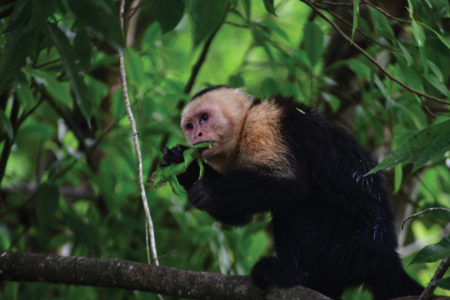 Monkeys and coatis have a strange relationship. In spite of the fact that the former are the primary predators of the latter, I have seen them together in a royal palm tree, side by side, happily feeding on palm flowers. One researcher at Hacienda Barú actually observed a capuchin monkey grooming a coati that was lying on a branch in a tree where a group of each species was resting peacefully. Yet on another occasion Hacienda Barú guide Pedro Porras and a group of visitors observed four capuchin monkeys mob a lone coati and throw him out of a tree where he fell through some lower branches and all the way to the ground, 10 meters (33 feet) below.
Monkeys and coatis have a strange relationship. In spite of the fact that the former are the primary predators of the latter, I have seen them together in a royal palm tree, side by side, happily feeding on palm flowers. One researcher at Hacienda Barú actually observed a capuchin monkey grooming a coati that was lying on a branch in a tree where a group of each species was resting peacefully. Yet on another occasion Hacienda Barú guide Pedro Porras and a group of visitors observed four capuchin monkeys mob a lone coati and throw him out of a tree where he fell through some lower branches and all the way to the ground, 10 meters (33 feet) below.
Knowing of the predation by capuchins of the white-nosed coati nests, I began to wonder about squirrels. Like coatis their nests are found in the tree tops, and are much more visible than the coati nests. Surely the capuchins prey on their young as well, I reasoned. Upon pondering this situation I realized that the only squirrels that I had ever seen in forested areas frequented by monkeys were the pygmy squirrels, not the more common variegated squirrels which seemed to shy away from monkey habitat. Nobody at Hacienda Barú has observed capuchin monkeys and variegated squirrels in the same habitat at the same time, and there is almost no overlap of their territories. Fortunately we now have an excellent field guide available, The Mammals of Costa Rica by Mark Wainwright. Wainwright tells us that capuchin monkeys have been known to: “…team up to chase squirrels, often knocking the squirrels to the ground, and then pouncing on them…” Though Wainwright doesn’t say so, we can presume that they then kill and eat the squirrel.
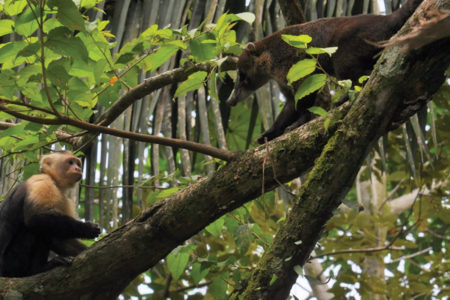 As we have seen, the campesinos were right; white-throated capuchin monkeys can be very vicious. This is not to condemn them; all wild animals have to eat to survive, and when their food is animal protein some other animal must die. Fortunately I have never heard of monkeys attacking humans, though I’m sure that there have been incidents, especially when people feed the monkeys. They tend to attack things much smaller than humans, things they can easily kill and eat. Had I had all of today’s wonderful information sources 47 years ago, I wouldn’t have gone so long with my misconceptions about these amazing primates. But then I wouldn’t have had so much fun learning.
As we have seen, the campesinos were right; white-throated capuchin monkeys can be very vicious. This is not to condemn them; all wild animals have to eat to survive, and when their food is animal protein some other animal must die. Fortunately I have never heard of monkeys attacking humans, though I’m sure that there have been incidents, especially when people feed the monkeys. They tend to attack things much smaller than humans, things they can easily kill and eat. Had I had all of today’s wonderful information sources 47 years ago, I wouldn’t have gone so long with my misconceptions about these amazing primates. But then I wouldn’t have had so much fun learning.
A big thank you to Hacienda Barú Biologist Guide Rigoberto Pereira for the amazing photo of the two monkeys eating the immature green iguana. That photo was the inspiration for this article.
Jack Ewing was born and educated in Colorado. In 1970 he and his wife Diane moved to the jungles of Costa Rica where they raised two children, Natalie and Chris. A newfound fascination with the rainforest was responsible for his transformation from cattle rancher into environmentalist and naturalist. His many years of living in the rainforest have rendered a multitude of personal experiences, many of which are recounted in his published collection of essays, Monkeys are Made of Chocolate. His latest book is, Where Jaguars & Tapirs Once Roamed: Ever-evolving Costa Rica. Jack and Diane live on and manage the Hacienda Barú National Wildlife Refuge, a well-known ecotourism destination on the southwest coast of Costa Rica.

